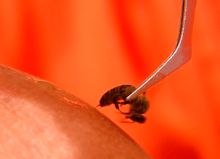Apitherapy
Apitherapy is a branch of alternative medicine that uses honey bee products, including honey, pollen, propolis, royal jelly and bee venom. Proponents of apitherapy make claims for its health benefits which are unsupported by evidence-based medicine.[1][2]
| This article is part of a series on |
| Alternative and pseudo‑medicine |
|---|
 |
|
General information
|
|
Fringe medicine and science
|
|
Conspiracy theories
|
|
|
|
Diagnoses
|

History
References to medical properties of bee products can be found in Chinese, Korean, Russian, Egyptian and Greek traditional medicine practices.[3][4] Apitherapy has been practiced since the times of Hippocrates and Galen.[5][6] The more modern study of apitherapy, specifically using bee venom, was initiated by Austrian physician Philipp Terč in his 1888 article "About a Peculiar Connection Between the Bee stings and Rheumatism."[7] More recent alternative medicine practice is attributed to the Hungarian physician Bodog F. Beck who coined the term "bee venom therapy" in 1935,[5] and to beekeeper Charles Mraz (1905–1999) in the latter half of the twentieth century.[8] In 1957, the USSR Ministry of Health sanctioned use of bee venom to treat certain ailments by approval of Nikolay Artemov's "Instruction for Bee Sting Venom Apitherapy."[9][10]
Health claims
Apitherapy is promoted as alternative medicine for several uses,[2][11] but its health claims are not supported by scientific evidence.[2] Bee venom or other honeybee products are ineffective for the treatment or prevention of cancer.[1]
In general, evidence for using honey in wound treatment is of such low quality that firm conclusions cannot be drawn.[12][13]
Risks
Adverse reactions to bee venom therapy are frequent.[14] Frequent exposure to the venom can also lead to arthropathy.[15] In sensitized persons, venom compounds can act as allergens, causing a spectrum of allergic reactions that can range from mild, local swelling to severe systemic reactions, anaphylactic shock, or even death.[16]
In March 2018 it was reported that a 55-year-old woman died after receiving "live bee acupuncture", suffering a severe anaphylactic episode which the apitherapy practitioner did not respond to by administering adrenaline.[17] While stabilized by ambulance personnel on the way to the hospital, she died a few weeks later from complications resulting in multiple organ failure.[18] Live bee acupuncture therapy is “unsafe and unadvisable,” according to researchers who studied the case.[16]
References
- Ades, Terri B.; Russel, Jill, eds. (2009). "Chapter 9: Pharmacologic and Biologic Therapies". American Cancer Society Complete Guide to Complementary and Alternative Cancer Therapies (2nd ed.). American Cancer Society. pp. 704–708. ISBN 978-0-944235-71-3.
- Barry R., Cassileth (2011). "Chapter 36: Apitherapy". The Complete Guide to Complementary Therapies in Cancer Care: Essential Information for Patients, Survivors and Health Professionals. World Scientific. pp. 221–224. ISBN 978-981-4335-66-9.
- Silva, J; Monge-Fuentes, V; Gomes, F; Lopes, K; Dos Anjos, L; Campos, G; Arenas, C; Biolchi, A; Gonçalves, J; Galante, P; Campos, L; Mortari, M (2015). "Pharmacological Alternatives for the Treatment of Neurodegenerative Disorders: Wasp and Bee Venoms and Their Components as New Neuroactive Tools". Toxins. 7 (8): 3179–3209. doi:10.3390/toxins7083179. PMC 4549745. PMID 26295258.
- Russian Federation; In: WHO Global Atlas of Traditional, Complementary and Alternative Medicine, Part 2; page 136. World Health Organization. 2005. ISBN 978-9241562867. Retrieved 8 September 2017.
- Kim, Christpher M.H. (4 June 2013). "Chapter 4: Apitherapy — Bee Venom Therapy". In Grassberger, Martin; Sherman, Ronald A.; Gileva, Olga S.; Kim, Christopher M.H.; Mumcuoglu, Kosta (eds.). Biotherapy – History, principles and practice: A practical guide to the diagnosis and treatment of disease using living organisms. Springer. pp. 77–78. ISBN 978-94-007-6585-6.
- Wilcox, Christie (9 August 2016). Venomous: How Earth's Deadliest Creatures Mastered Biochemistry. Farrar, Straus and Giroux. p. 186. ISBN 978-0-374-71221-1.
- Terč, Philipp (26 August 1888). "Ueber eine merkwürdige Beziehung des Bienenstichs zum Rheumatismus" [About a Peculiar Connection Between the Bee stings and Rheumatism]. Wiener Medizinische Press (in German). 29 (35): 1261–1263. Lay summary – Berlin Veterinary Weekly.
- "History of Apitherapy". Medicineworld.org. Retrieved 31 August 2016.
- Berenbaum, May R. (January 1995). Bugs in the System: Insects and Their Impact on Human Affairs. Helix Books. p. 175. ISBN 978-0-201-62499-1.
- Palmer, D. J. (27 February 1964). "Collecting bee venom for research". New Scientist. Vol. 21 no. 380. London. pp. 546–547. ISSN 0262-4079.
- Premratanachai, Pongsathon; Chanchao, Chanpen (May 2014). "Review of the anticancer activities of bee products". Asian Pacific Journal of Tropical Biomedicine. 4 (5): 337–344. doi:10.12980/APJTB.4.2014C1262. PMC 3985046. PMID 25182716.
- Jull, Andrew B.; Cullum, Nicky; Dumville, Jo C.; Westby, Maggie J.; Deshpande, Sohan; Walker, Natalie (2015). "Honey as a topical treatment for wounds". Cochrane Database of Systematic Reviews (3): CD005083. doi:10.1002/14651858.cd005083.pub4. PMID 25742878.
Honey appears to heal partial thickness burns more quickly than conventional treatment (which included polyurethane film, paraffin gauze, soframycin-impregnated gauze, sterile linen and leaving the burns exposed) and infected post-operative wounds more quickly than antiseptics and gauze.
- Majtan, J (2014). "Honey: an immunomodulator in wound healing". Wound Repair Regen. 22 (2 Mar–Apr): 187–192. doi:10.1111/wrr.12117. PMID 24612472.
- Park, Jeong Hwen; Yim, Bo Kyung; Lee, Jun-Hwan; Lee, Sangun; Kim, Tae-Hun (21 May 2015). "Risk Associated with Bee Venom Therapy: A Systematic Review and Meta-Analysis". PLOS ONE. 10 (5): e0126971. doi:10.1371/journal.pone.0126971. PMC 4440710. PMID 25996493.
- Cuende, E.; Fraguas, J.; Pena, J.E.; Pena, F.; Garcia, J.C.; Gonzalez, M. (1999). "Beekeeper's Arthropathy". The Journal of Rheumatology. 26 (12): 2684–2690. doi:10.1016/j.reuma.2018.02.012. PMID 29530760. Retrieved 24 March 2018.
- Vazquez-Revuelta, Madrigal-Burgaleta. "Death due to Live Bee Acupuncture Apitherapy" (PDF). The Journal of Investigational Allergology and Clinical Immunology. Esmon. Retrieved 21 March 2018.
- "Woman dies after undergoing 'bee acupuncture' treatment famously touted by Gwyneth Paltrow". SFGate. Retrieved 2018-03-21.
- Lagerquist, Jeff. "Woman's death after bee sting therapy shows practice is 'unsafe': study". CTV News. Bell Media. Retrieved 21 March 2018.
